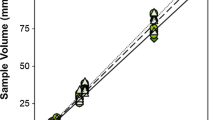Summary
Dew droplets collected with pipettes from coniferous needles were analysed for their ionic composition. Almost all samples of dew taken from Scots pine trees (Pinus sylvestris) showed significantly higher ion concentrations than those taken from Norway spruce trees (Picea abies). This can be explained by the micromorphology of the needle surface. The higher microscale roughness of the wax layer of a pine needle causes a more efficient flux of atmospheric aerosol particles compared to the spruce needle surface. Dew on coniferous needles is shown to be capable of maintaining pH values below 3 for several hours.
Similar content being viewed by others
References
ApSimon HM, Kruse M, Bell JB (1987) Ammonia emissions and their role in acid deposition. Atmos Environ 21: 1939–1946
Brimblecombe P, Todd LJ (1977) Sodium and potassium in dew. Atmos Environ 11: 649–650
Cadle SH, Groblicki PJ (1984) The composition of dew in an urban area. General Motors Research Publication GMR-4512 (1983). In: Samson PJ (ed) Transactions of an APCA Specialty Conference, The Meteorology of Acid Deposition. Air Pollution Control Association, Pittsburgh, Pa.: 17–29
Chameides WL (1987) Acid dew and the role of chemistry in the dry deposition of reactive gases to wetted surfaces. J Geophys Res 92: 11895–11908
Clegg SL, Brimblecombe P (1988a) Equilibrium partial pressures of strong acids over concentrated saline solutions. I. HNO3. Atmos Environ 22: 91–100
Clegg SL, Brimblecombe P (1988b) Equilibrium partial pressures of strong acids over concentrated saline solutions. II. HCl. Atmos Environ 22: 117–129
Engel H (1942) Das Verhalten der Blätter bei Benetzung mit Wasser. Jahrb Wiss Bot 88:816–861
Fowler D, Unsworth MH (1974) Dry deposition of sulphur dioxide on wheat. Nature 249: 389–390
Frevert T (1983) Hydrochemisches Grundpraktikum. UTB 1256. Birkhäuser, Basel
Gelbke W (1955) Untersuchungen zur Methodik der Taumessung an Hand dreijähriger Taumessungen in Greifswald. Abhandlung des meteorologischen und hydrologischen Dienstes der DDR. Akademie Verlag, Berlin
Hofmann G (1955) Die Thermodynamik der Taubildung. Ber Dtsch Wetterdienstes. No. 18, Bad Kissingen
Jeffree CE, Baker EA, Holloway PJ (1976) Origins of the fine structure of plant epicuticular waxes; In: Dickinson CH, Preece TF (eds) Microbiology of aerial plant surfaces. Academic Press, London, pp 119–158
Klemm O (1988) Säure/Base- und redoxchemische Simulation des Verdampfens von Niederschlagswasser von Fichtennadeln. Dissertation, University of Bayreuth
Kreutzer K, Bittersohl J (1986) Stoffauswaschungen aus Fichtenkronen (Picea abies (L.) Karst) durch saure Beregnung. Forstwiss Centralbl 105: 357–363
Leuning R, Cremer KW (1988) Leaf temperatures during radiation frost. I. Observations. Agric For Meteorol 42: 121–133
Ludwig J, Klemm O (1988) Organic acids in different size classes of atmospheric paniculate material. Tellus 40B: 340–347
Mengel K, Lutz HJ, Breininger MT (1987) Auswaschung von Nährstoffen durch sauren Nebel aus jungen intakten Fichten (Picea abies). Z Pflanzenernähr Bodenkd 150: 61–68
Monteith JL (1963) Dew: facts and fallacies. In: Rutter AJ, Whitehead FH (eds) The water relations of plants. Wiley, New York, pp 37–56
Mulawa PA, Cadle SA, Lipari F, Aug CC, Vandervennet RT (1986) Urban dew: its composition and influence on dry deposition rates. Atmos Environ 20: 1389–1396
Oren R, Werk KS, Schulze ED (1986) Relationship between foliage and conducting xylem in Picea abies (L.) Karst. Trees 1: 61–69
Pierson WR, Brachaczek WW, Gorse RA Jr, Japar SM, Norbeck JM (1986) On the acidity of dew. J Geophys Res 91: 4083–4096
Pierson WR, Brachaczek WW, Japar SM, Cass GR, Solomon PA (1988) Dry deposition and dew chemistry in Claremont, California, during the 1985 nitrogen species method comparison study. Atmos Environ 8: 1657–1663
Pitzer KS (1979) Theory: ion interaction approach. In: Pytkovicz RM (ed) Activity coefficients in electrolyte solutions. CRC Press, Boca Raton, pp 157–208
Sehmel GA (1980) Particle and gas dry deposition: a review. Atmos Environ 14: 983–1011
Skiba U, Peirson-Smith TJ, Cresser MS (1986) Effects of simulated precipitation acidified with sulfuric and/or nitric acid on the throughfall chemistry of Sitka spruce Picea sitchensis and heather Calluna vulgaris. Environ Pollut 11: 255–270
Talbot RW, Beecher KM, Harriss RC, Cofer WR (1988) Atmospheric geochemistry of formic and acetic acids at a mid-latitude temperate site. J Geophys Res 93: 1638–1652
Trautner F, Eiden R (1988) A measuring device to quantify deposition of fogwater and ionic input by fog on small spruce trees. Trees 2: 92–95
Walcek CJ, Brost A, Chang JS, Weseley MS (1986) SO2, sulfate and HNO3 deposition velocities computed using regional landuse and meteorological data. Atmos Environ 20: 949–964
Wilcoxon F (1945) Individual comparisons by ranking methods. Biometrics 1: 80–83
Wisniewski J (1982) The potential acidity associated with dews, frosts and fogs. Water Air Soil Pollut 17: 169–171
Wood NB (1981) A simple method for the calculation of turbulent deposition to smooth and rough surfaces. J Aerosol Sci 12: 275–290
Yaloon DH, Ganor E (1968) Chemical composition of dew and dry fallout in Jerusalem, Israel. Nature 217: 1139–1141
Author information
Authors and Affiliations
Rights and permissions
About this article
Cite this article
Burkhardt, J., Eiden, R. The ion concentration of dew condensed on Norway spruce (Picea abies (L.) Karst.) and Scots pine (Pinus sylvestris L.) needles. Trees 4, 22–26 (1990). https://doi.org/10.1007/BF00226236
Received:
Issue Date:
DOI: https://doi.org/10.1007/BF00226236




